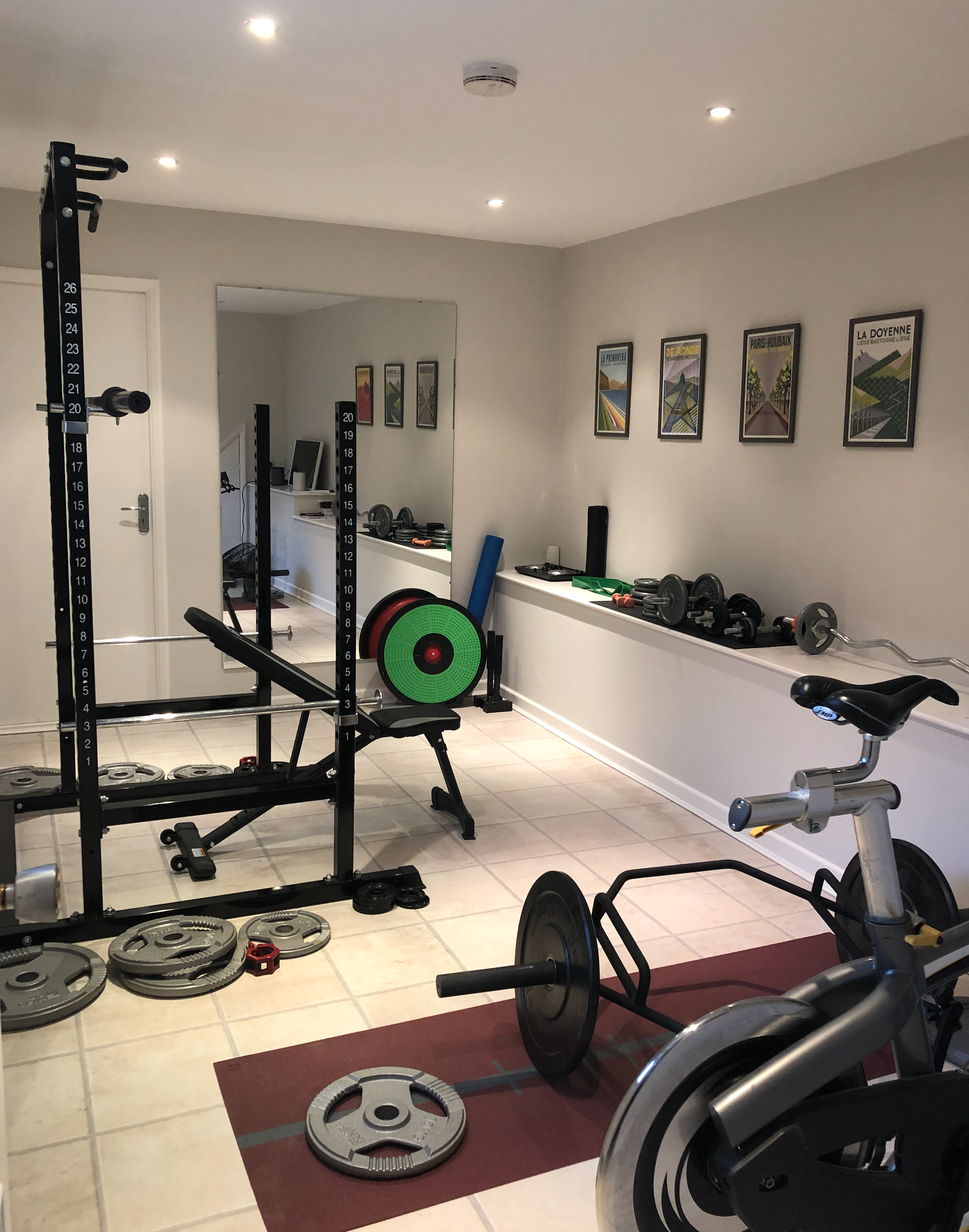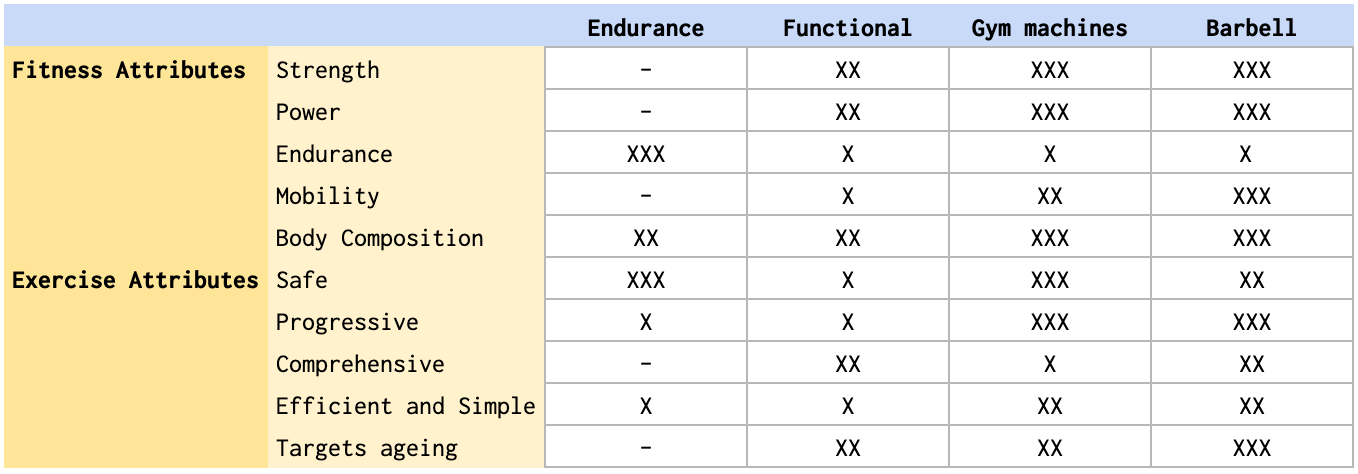Do you even lift?
1. Introduction
Obviously Betteridge has it covered already, but if you need further convincing you should watch this.
Anyway, I had some rather tedious problems with my hip a couple of years ago which caused me all manner of unnecessary bother. Thankfully the problem resolved without serious intervention and so I’m rightly feeling blessed. I’m also blessed in another way - my rehabilitation led me to the most rewarding of new hobbies : strength training.
A gratuitous shot of my gym at home of which I’m inordinately proud (I needed a lead picture for the blog post, the alternative was a ‘progress pic’ so be feeling a little bit blessed yourself).

Anyway, I’ve been ‘at it’ for about 18 months - three times a week and have barely missed a session in that time. Equipping the gym with kit was not super-expensive (I mostly got my gear from Mirafit) and the physical and psychological rewards are numerous.
I’m mostly inspired by the book Barbell Prescription by Jonathan Sullivan and Andy Baker, which further takes it’s inspiration from Mark Rippetoe’s super-famous Starting Strength.
The Barbell Prescription is aimed at the over-40s and comes most highly recommended. The marketing and presentation of the book is a highly suspect but the first two-thirds of the content is solid and highly motivating theory. I’ll do my best to summarise the key points in this post.
The take-home though is simple : Everyone who can lift weights should lift weights.
2. Why?
Simple : getting old is shit. The physical characteristics of ageing are
- Loss of muscle and strength
- Brittle bones
- Ligament and joint problems
- Deterioration of mobility and balance
There’s a quadfecta of aggravation that we’d all do well to try and forestall for as long as we can.
As we get older there’s a intuitive inclination to start taking things more easily. What if, instead, we ought to be doing precisely the opposite and get busy kicking our own arses to get and stay strong for as long as we possibly can?
Our bodies need acute stresses to get stronger and, as we’ll see, barbell training is the single best method of administering that stress.
The Barbell Prescription defines the key attributes of fitness and features of an exercise program and compares how different exercise modalities deliver against them.
3. What is fitness?
Fitness has the following attributes
- Strength
- Ability to produce force
- Power
- Abiiity to produce force quickly
- Endurance
- Ability to engage in sustained activity
- Mobility
- Flexibility, agility, coordination
- Body composition
- Ratio of lean to fat mass
4. What are we looking for from our exercise programme?
An ideal exercise programme should be
- Safe
- Does not increase the likelihood of illness or injury.
- Progressive
- Has a wide range of ‘effective doses’ and allows small, measurable increments of loading as you get fitter.
- Comprehensive
- Hits the big five of strength, power, endurance, mobility and body composition.
- Simple
- Practical, accessible and time-efficient.
- Specifically targets the challenges of ageing
- Arresting metabolic syndrome, reduce visceral fat, arrest of reverse muscle and bone density losses and fight frailty.
5. How do different types of exercise fare?
Before looking at the different types of exercise and how well they support both the fitness and exercise goals, the obvious should be stated - that pretty much all exercise is better than no exercise.
All within sensible bounds of course; everything is dose-dependent : none bad, some good, too much bad again especially as we get older. “There’s always an n-shaped curve” as I’m overly fond of saying.

Endurance is stuff like running, cycling, swimming and so on. Repetitive, low-intensity, great fun (particularly if it’s cycling :-)) and better than sitting on your arse. The risk of injury increases with age - especially running - and progression tends to be doing it for longer and longer with both diminishing beneficial returns and further increased risk of injury. Cycling, the king of endurance activity, is an ‘unnatural’ movement, consequently making some bits strong and other bits weak and this imbalance can cause problems in the long term.
Functional Bootcamp-style exercise - which I unhelpfully and provocatively call ‘swinging things around’. Boxing, swinging ropes, manhandling kettlebells, that kind of thing. Great fun, social, and beneficial no doubt. Probably well tolerated by younger folks but the risks of injury must increase with age especially given the combination of variety of exercise and the urge to ‘push’. It lacks decent, measurable progression, too much variation and is exercise rather than training.
Gym Machines are a safe, progressive and decent enough way to hit most of the fitness attributes. However, they focus on training individual muscles rather than movements, the range of movement is limited, and can’t be adapted to the match the size of the trainee.
Barbell training is the king of exercising. If you did one thing this would be it. The four big compound exercises (ie deadlift, squat, press and bench press) cover a huge bulk of the important musculature and train ‘movements’ rather than ‘muscles’. There are only four exercises to learn, to start with anyway, and the minimum dose is an empty bar of 20kg with finely titrable progression all the way up to close to your genetic potential. The motto is ‘simple, hard, effective’ (see the podcast below). The sessions are short (around 45 minutes to an hour) and done optimally three times a week.
6. My approach
My principal objective : be stronger at 60 than I will be at 50.
Most fitness regimes promote novelty as a means of generating motivation which is perfectly understandable. However a really simple program, repeated frequently, with precisely measured progression can provided more than enough motivation. What could be more motivating that making constant progress, knowing you are making constant progress and feeling the benefits along the way?
Barbell training is incredibly simple : rock up and lift a bit more than you did before. That’s all there is to it for a long time.
I’m in absolutely no hurry to race to my genetic potential and will take any gradient of improvement, no matter how slight. This includes having fractional plates as light at 0.25kg which enable progressions of half a kilo at a time.
This gradual progression helps avoid injuries and sustains motivation as the weight on the bar keeps increasing : for months, years even, before you need to play around with other training variables other than the amount of iron lifted in each session.
7. Conclusion
As Mark Rippetoe says
Strong people are harder to kill than weak people, and more useful in general
Barbell training is the most powerful, rational, simple, safe and effective approach to fitness.
The goal is not necessarily longevity, but the compression of morbidity. As you get older you get weaker - training to specifically counter this seems a straightforward, common sense proposition.
Does that render all other types of exercise redundant? I seriously doubt it. I throw in some cycling, HIIT and yoga on a weekly basis. But if you could only do one thing to hold back the tide of ageing? My vote currently goes to the barbell.
